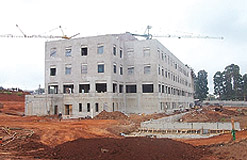While not typically considered a software developer, the U.S. Army Corps of Engineers is turning some heads with a Web-based product developed in-house to improve the design review process. The Corps and several other federal agencies are using the software to manage design reviews on hundreds of new construction projects. And users say the new tools are shaving weeks off project schedules and thousands of dollars off total costs.
The Design Review and Checking system (DrChecks), developed at the Corps' Construction Engineering Research Laboratory in Champaign, Ill., links designers, reviewers, project managers and other interested parties via the Internet to track the review of construction plans and specifications. While bearing similarities to commercial Web-collaboration tools developed for the architecture, engineering and construction market, DrChecks provides a couple of attractive twists for federal agencies. These include additional security, since the software and data are hosted on a federal computer system, and a structured, database-driven approach specifically geared toward managing design reviews.
"We needed a way to communicate design issues formally," says Bill East, principal investigator at CERL and lead developer of ProjNet, a series of applications that includes DrChecks and other programs geared toward federally constructed facilities. Commercial Web-based tools allow interaction through e-mail and discussion groups, but those tend to be "free-for-alls," he says.
Using a standard Web browser, DrChecks users can log on to check a project's review status, submit comments and responses and sort comments by date, discipline, reviewer and other categories. Typically, a project manager creates review phases for each project and reviewers submit comments during each phase. Designers then evaluate and respond to comments. Communication is logged to a database. Drawings and other files can be attached to postings.
The structured approach helps reviewers and designers monitor and resolve issues more efficiently, says Robert Clarke, an architect and design information technology manager with the U.S. State Dept.'s Overseas Building Operations in Rossyln, Va. As reviewers, "we have been good at raising issues, but bringing issues to resolution has been a challenge," he says.
 |
| ON LINE East (above) developed review system that will benefit Ft. Belvoir addition (left) and embassy (bottom). (Photo credit) |
LESSONS LEARNED. Key issues flagged as "lessons learned" are shared with other parties likely to encounter the same issues. Each potential "LL" item is sent to discipline-specific experts to determine if the item is technically accurate and likely to impact operations. If accepted, the LL is forwarded to other parties and added to a knowledge base accessible via the Web.
The State Dept. first used DrChecks on a design-build embassy in Uganda in 1999. With an 18-month fast-track schedule, "some people said [introducing a new review program] was crazy," says Nancy Wilkie, design quality assurance coordinator with the OBO. "But after we tried it, we never looked back."
 |
| (Illustration by Guy Lawrence for ENR) |
OBO has used the latest version of DrChecks on 23 reviews and logged over 4,000 comments. A previous version hosted locally by the State Dept. has been used on 461 projects to track over 54,000 design issues. Clarke estimates DrChecks can save up to $500,000 on a $100-million project through efficient reviews and improved design, which decreases change orders and delays.
Before adopting DrChecks, OBO used a paper-based system to exchange comments, an inefficient process that was difficult to track, says Wilkie. OBO has since restructured its review procedures around the DrChecks system, developing an "Integrated Design Review Process" with six key steps–a kick-off meeting, collaborative review, technical coordination, designer response, reviewer back-check and a resolution meeting. The technical coordination is intended to weed out comments that are redundant or out of scope before they are passed on to designers. "We can eliminate 20% of comments in this step," says Wilkie.
 |
| (Illustration by Guy Lawrence for ENR) |
PRIVATE EYES. Increased government efficiency also benefits private consultants and contractors, says Joe Kelly, technical services manager in the international division of Charlotte, N.C.-based J.A. Jones Inc. The firm is using DrChecks on three design-build embassy projects it won last year. "All the comments are in one central location," he says. "You can see whose court the ball is in." Nearly 4,000 of the 10,000 DrChecks users are from the private sector, says East.
The Corps is finding similar savings. On a typical $3-million project, savings could reach $50,000, says Pete Rossbach, a structural engineer at the Corps' Washington, D.C., headquarters and former chief structural engineer in the Baltimore district. A combination of value engineering and lessons-learned applications on a barracks construction project at Fort Meade, Md., saved $6 million, he estimates.
The Corps hopes to net big savings on a 300,000-sq-ft addition to a building at Fort Belvoir, Va., this year, says Scott Drumheller, project manager in the Baltimore district. The existing 800,000-sq-ft building had "thousands of comments" and was managed with the Automated Review Management System (ARMS), a cumbersome, 1980s-vintage solution, he says. Using DrChecks on the addition, Drumheller expects better communication between designers and reviewers. "You can see your comments in context with the rest of the review effort and get more of a global perspective," he says.
The comment clearinghouse is particularly helpful with projects across different time zones, says David Worthington, systems administrator with the the Corps' Transatlantic Center, Winchester, Va. "It's instantaneous knowledge," he says. Project participants can access the system at any time of day. On smaller projects, DrChecks has decreased the review period from weeks to as little as 48 hours, adds Wilkie.
SECURE SYSTEM. The added security of hosting software and data on government computers is also a key benefit to DrChecks, say government officials. "We looked at commercial sites, but couldn't commit to that approach because of the security issues," says Clarke.
"We needed to securely transfer information," says Wilkie. "Since the Corps hosts the site and they are a federal agency, there's a certain level of comfort." After initially hosting DrChecks on its own computers, the State Dept. established an accreditation process to ensure physical security of equipment and data if hosted externally by the Corps.
With security measures in place, the State Dept. now takes full advantage of DrChecks communication exchanges. In the early days of DrChecks, it would compile comments in a spreadsheet and send an electronic file to designers, who would fill in responses and return the edited file.
FEE BASIS. In addition to the Corps and State Dept., the U.S. Naval Facilities Engineering Command and the General Services Administration also are using the system. The National Aeronautics and Space Administration is anxious to launch a trial in the no-too-distant future, says East. The system is offered on a subscription basis to government agencies, who pay an annual fee ranging from $10,000 to "several hundred thousand dollars" per site, depending on the number of users, he says. A private contractor, Resource Center Enterprises, Urbana, Ill., provides technical support.
The Corps may have bigger plans for the ProjNet suite. Commercial subscription services for private firms are expected to be available this summer, says East. The suite also may be expanded to applications outside of construction, says Dwight Beranek, chief of engineering and construction at Corps headquarters. "The lessons learned concept could have applications in personnel, accounting and other types of project management," he says.

Post a comment to this article
Report Abusive Comment